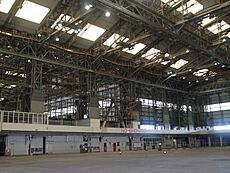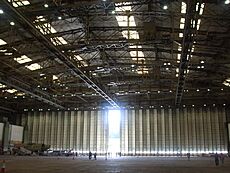Bristol Arena facts for kids
|
Bristol Arena
|
|
| Location | Southmead, Bristol |
|---|---|
| Coordinates | 51°30′59″N 2°35′06″W / 51.5163°N 2.5851°W |
| Owner | YTL Corporation |
| Capacity | 19,000 |
| Construction | |
| Broke ground | 2003 (original BTM location) |
| Built | TBC |
| Opened | 2027 (proposed) |
| Construction cost | £100 million |
| Architect | Grimshaw Architects with MANICA Architecture |
| General contractor | Avison Young |
The YTL Arena Bristol is a huge indoor stadium planned for Bristol, England. It's designed to hold 19,000 people. This arena will be built inside the old Filton Airfield's Brabazon hangar.
Earlier plans for the arena were to build it near Bristol Temple Meads railway station. This location was called 'Arena Island'. The city council approved money for this plan in 2014. A company called Populous created the winning design in 2015.
However, in 2017, they had trouble agreeing on building costs. By September 2018, the plans for the Temple Meads site were stopped. This was mainly because of high costs and risks.
In 2019, a company called YTL Corporation suggested building the arena at the old Filton Airfield. They received permission in 2020. Construction was supposed to start in 2022 and finish by early 2026. As of mid-2025, construction work has not yet begun. The completion date is now expected to be 2027 at the earliest.
Contents
Why Bristol Needs a Big Arena
Bristol is one of the largest cities in the United Kingdom. For a long time, it did not have a large indoor stadium. Cities like Leeds have big arenas for concerts and events. Bristol's biggest music places, like the Colston Hall (now Bristol Beacon) and the O2 Academy, only hold about 2,000 people.
Early Ideas for the Arena
Plans for a Bristol Arena first came up in 2003. It was meant to have 10,000 seats. The arena would host music shows, sports, and big meetings. It was hoped to open by 2008. This was to help Bristol's bid to become the European Capital of Culture.
By 2007, work had not started, even though millions of pounds were spent. The plans were stopped later that year. This was because too much public money would be needed.
New Plans and Challenges
By 2009, new ideas for the arena came up. One idea was similar to the first plan near Temple Meads. Another idea was to build it next to Bristol City's planned football stadium. Legal issues with the football stadium made the council look at the Temple Meads site again in 2012.
The land for the arena near Temple Meads was once a train depot. It is part of the Bristol Temple Quarter Enterprise Zone. In 2013, a group called the Homes and Communities Agency (HCA) agreed to pay for a new road bridge. This bridge would connect the arena site to the railway station.
The HCA gave the land to Bristol City Council in 2015. The bridge, called Brock's Bridge, was built between March and September 2015. It has paths for cars, bikes, and people walking.
Designing the First Arena
After becoming mayor, George Ferguson started a contest. He wanted the best design for a 12,000-seat arena. He promised it would be very eco-friendly. He also said it would be ready within four years.
In February 2014, the city council approved the money for the arena. The total cost was £91 million. The council would pay £38 million. The rest would come from the West of England Local Enterprise Partnership.
In November 2014, five architect companies were chosen to design the arena. Populous won the design contest in March 2015. Their design aimed for a high environmental rating. The arena could change its layout for different events. It could hold from 4,000 to 12,000 people.
Problems with the First Plan
In March 2016, the arena plans faced a problem. The city's planning committee said the plans were "defective." They needed more information about parking and transport. Mayor George Ferguson said this decision put the whole project at risk.
After more updates to the transport plan, the arena finally received permission in April 2016. The planning committee agreed to the updated plans.
In January 2017, the arena's opening was delayed to 2020. This was because the council and the building company could not agree on costs. Later, another company, Buckingham Group, started preliminary work.
In November 2017, news came out about building the arena at the Brabazon Hangar. This hangar is at the old Filton Airfield.
In September 2018, Mayor Marvin Rees stopped the plans for the Temple Meads site. He said the Brabazon Hangar was the only choice. His main reasons were the high building cost and future financial risks. He also said the Temple Meads arena would be too small for major events.
Parking Concerns
Many people worried about parking at the Temple Quarter arena. The first plans had very few parking spaces. Mayor George Ferguson said it would be "mad" to put a lot of parking there. In February 2016, the council considered adding a larger car park.
Current Plans for Filton Airfield
The company that owns the old Bristol Filton Airport, YTL Corporation, shared new plans in early 2019. They wanted to build a 17,000-seat arena inside the old Brabazon hangar. They are working with Avison Young, Grimshaw, and MANICA Architecture.
The arena's design allows for flexible seating. It can hold from 4,000 to 17,000 people. The plans include a special walkway and a bridge over a railway line. The new entrance will be raised above the hangar floor.
The east and west hangars will also be used. One will become a "Festival Hall" for exhibitions and large events. The other, "The Hub," will have small businesses, food places, and fun activities.
Construction and Delays
Planning permission for the Filton site was given in 2020. Construction was expected to start in 2022 and finish by 2024. The old airfield site is also planned for 2,675 new homes. This new area is called Brabazon. Homes started being built in 2020.
In January 2023, the arena's opening was delayed again. It was then expected in late 2025 or early 2026. However, the arena's capacity was increased to 19,000 seats. The arena is designed to be carbon-neutral and open all year.
In February 2023, the West of England Combined Authority (WECA) said that planned rail improvements were under review. Costs had risen to over £10 million. This was due to design changes and high inflation.
In January 2024, YTL received permission to build 1,500 student apartments. They also got permission for 400 private homes near the arena. In May 2024, plans were submitted for an outdoor cinema. This area could also become an ice rink in winter. It would also have courts for sports like badminton and basketball.
In September 2024, the developers confirmed that construction had not yet started. They were still preparing the site. The opening date was pushed back to 2027 at the earliest. In January 2025, it was reported that 2028 was more likely. YTL submitted updated designs for the arena's outside in December 2024.
See also
- Bristol Beacon, Bristol's current largest concert venue
- O2 Academy Bristol, Bristol's second largest concert venue
- Motorpoint Arena Cardiff, a similar arena nearby




